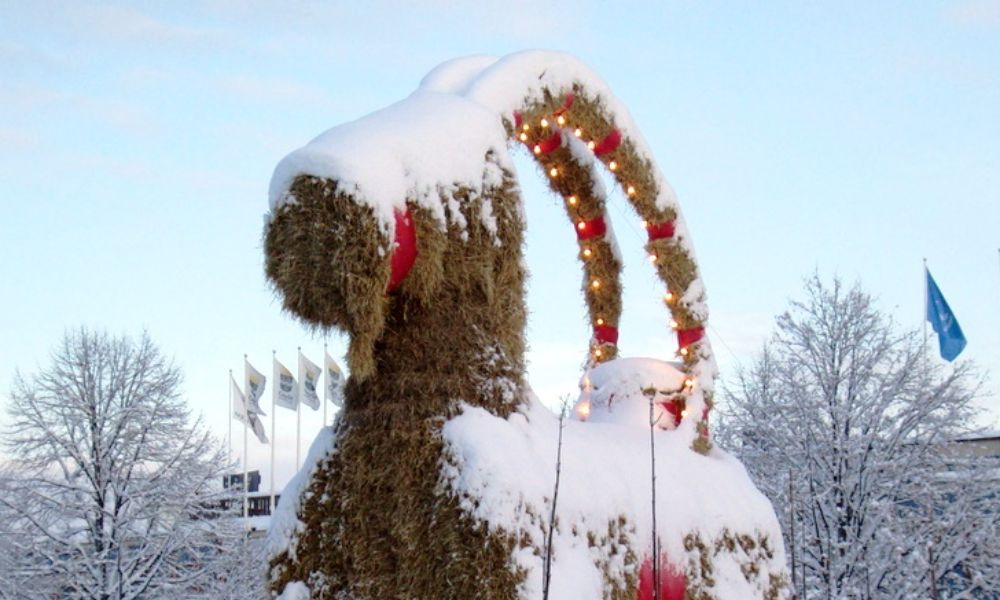The northern nations of Europe often have particularly close connections with winter and yuletide celebrations, given their association with these seasons.
The Gavle goat is one of many such traditions, and though in its current form it is not an especially old tradition, it comes from a much older habit of Swedish celebrations.
Let’s look further into this.

What is the Gavle Goat?
The Gavle Goat itself is a large, usually straw goat, built in the first days of Advent in the Swedish town of Gavle.
Depending on the calendar year, the first days of Advent, according to Christian tradition in the west, is either early December or late November.
This is when the goat is erected, where it remains, hopefully, throughout the Christmas season.
Gavle is a medium sized city on the eastern shores of Sweden, towards the south of the country.
The goat serves as both a celebration and tradition for locals as well as a tourist attraction.
It is displayed in Slottstorget, or the Castle Square, in the centre of town.
It was first proposed in 1966, when a local advertising consultant had the idea of constructing a giant version of the traditional Yule Goat, found throughout Sweden during the festive season.
Funding and construction have passed through a number of different hands throughout the years.
I’ll look at who has built it and builds it currently shortly, but at first it was at least financed by a group of businessmen in Gavle.
These kinds of wicker and straw constructions are an extremely old European tradition, and are often associated with many pagan rites and customs.
While the Swedish Yule Goat, now, is ostensibly a Christian celebration of Christmas, it no doubt has connections to the past that are extremely far-reaching.
Though the Gavle goat is an invention of the mid-twentieth century, the Swedish Yule Goat is far older than that.
Let’s look at that more generally.
What is the Swedish Yule Goat?
The Yule Goat is a common tradition throughout virtually all of Scandinavia.
Again, typically, they are made of straw and are only small in size—often small enough to be hung on a Christmas tree.
So, you can see the enterprising and ambitious nature of the person who suggested the giant Gavle goat.
As I mentioned, the origins of this tradition stretch far back into the mists of time and can be traced to Germanic paganism.
For this reason, we can’t be certain of the exact origin.
However, we do know that the celebration was about the sun’s re-entry into Capricornus, the astrological sign.
In Norse tradition, the chariot of the god who pulls the sun through the sky is drawn by a pair of goats.
Thus, goats are a symbol for the sun in these cultures.
There was also often a kid goat sacrificed in honor of Njord, the Nordic god of agriculture, to bring a bountiful harvest.
In Sweden in particular, it was believed that the spirit of the Yuletide goat would arrive in the days leading up to the celebrations to ensure preparations were being carried out correctly.
Thus, you might say the whole tradition is one of maintaining a connection with the north’s pagan past, as they do in many other ways also.
So, who builds the Gavle goat, today?
Who builds the Gavle Goat?
Originally, the Gavle goat was built by the Gavle fire department.
As you can see, from the earliest days, they were anticipating potential fire hazards and even vandalism.
The fire department designed and built it for the first few years.
Up until 1971, the goat, as I mentioned, was financed by a team of local businessmen.
Since 2003, the construction of the goat is assigned to a group known as the ALU workers.
These are otherwise unemployed people who volunteer to build the goat.
Why do they burn down the Gavle goat?
So, after all that effort, why does the goat get burned down?
Well, the answer is that it isn’t part of the tradition.
It’s unfortunately become an unwanted part of the tradition that vandals burn down the goat after it is constructed during the season.
It’s almost seen as a challenge, at a certain point.
38 of the 56 goats that have been built since 1966 have been successfully burned down.
That is well over half.
The perpetrators are often caught, but not always.
It carries a three-month prison sentence and a charge of aggravated property damage.
So, while it has a rather troubled history, the people of Gavle have not been deterred.
They still doggedly erect it year after year in hopes that it can be kept free from reckless vandals.
But it has a very interesting history apart from that, and if you are ever in that part of the world, then it’s certainly a great thing to see at Advent time.
